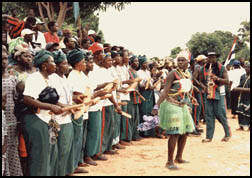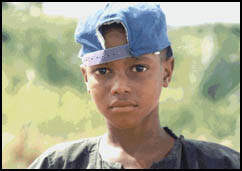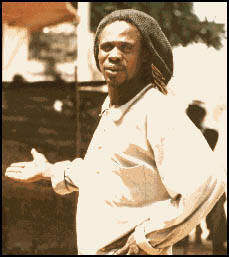 PEOPLE PEOPLE |

The Gambia's population is put at nearly 1.4 million by July 2000 estimation. The country's high fertility rate at 5.7 and a declining mortality rate has resulted in a very high population growth rate of 4.1% (one of the fastest in the world). The relative socio-political stability in a turbulent region has also attracted an influx of refugees form war-ravaged sub-regional neighbours and a favourably strong currency has also attracted indigenous of many African countries into The Gambia. The percentage of non-indigenous in The Gambia is estimated at 30%. Its population of 1.4 million lives within the narrow belt extending from either side of The River Gambia. The Gambians are usually tall, dark and sturdy people with fine features and an easygoing charm. Each ethnic group speaks its own language, but English is commonly spoken as well as being the official language of the country. There not only is harmony between the different groups, but a fusion is taking place by cultural interaction and intermarriage, to an extent that the Gambia can be called a melting pot of West African ethnic groups where a modern composite African is being evolved. The population is predominantly Muslim with more than 90% following Islam. The remaining 10% are mostly Christians of different denominations including Anglicans, Methodists, and Roman Catholics. Most of the people are strict in their Religious practices and the devout Muslims can be seen praying not only in Mosques but also in other public places at all prayer times of the day. There is, however, no fanaticism and amity prevails between religious and ethnic groups. The different ethnic groups are as follows;
 Tribes Tribes |
WOLOF
The Wolof mostly inhabit the western areas of the country. Traditionally farmers and traders, the Wolof today controls a great deal of commerce. The Wolof language is used as a common tongue in many parts of Gambia often instead of English. The Wolof are almost exclusively Muslim.
MANDINKA
The Mandinka are the single largest group in Gambia, The Mandinka people are also called Mandingo, and are related to other Manding-speaking groups such as the Bambara of Mali, where they originate. They are thought to have migrated to the Senegambia region between the 13th and early 16th centuries, and to have brought Islam with them.
Traditionally engaged in farming and fishing, most Mandinka people are Muslim, and they also have a strong musical tradition. Islamic feast days, such as the end of Ramadan, and family celebrations, such as a Wedding or circumcision, or even the arrival of a special guest, are often seen as very good reasons for some music and dancing.
FULA

The Fula are found across West Africa, as far east as Sudan and south into countries like Ghana and Nigeria, although they look on the Futa Toro region in northern Senegal as their cultural homeland. The Fula are also called Fulani and Fulbe. These names, as well as Fulfulde or Pulaar also knows their language.
The Fula are traditionally nomadic cattle herders, and the constant search for grazing land may go some way toward explaining their dispersal across the region. Wolof or people from other tribes who own cattle will often entrust them to Fula keepers. The Fula tend to have light skin, compared with most peoples of sub-Saharan Africa, and their own oral history says they have Caucasian origins. Other sources give them Semitic or Arab origin. Fula are mostly, but not exclusively, Muslim and their far-flung nature means they intermarry with other groups.
|
TUKULOR
The Tukulor people are found predominantly in the Fula Toro region in northern Senegal, although their origins are vague, and their history and culture overlap with the Fula . Some authorities say the Tukulor are Fula, or the outcome of intermarrying between Fula and Wolof. Their language is classified as a dialect of Fula. One difference however is that the Tukulor embraced Islam much earlier than the Fula, in the 10th or 11th century when the religion was first carried north across the Sahara form Morocco. The Tukulor were know for their extreme religious zeal and were responsible for converting many other groups, and for inspiring many of the anti-colonial jihads of the 19th century.
SERER
The Serer are less widespread than any of the other groups mentioned above. They are concentrated just across the border in northwest Gambia. They are thought to have migrated from southern Senegal in the 16th century (they seem to share common origins with the Diola) and in some areas they have intermarried with the Mandinka or Wolof people, or adopted their languages. In many cases the Serer have adopted Islam too, although there are pockets of Christianity.

DIOLA
The Diola inhabit the area southwest of Gambia, where their name is spelt Jola. They also inhabit various parts of northern Guinea-Bissau. Traditional Diola occupations include farming, fishing and palm wine tapping.
The diola do not have a strong oral tradition (that is they do not have the equivalent of griots, which can keep traditions and history alive for centuries amongst other tribes) and their origins are obscure. It is thought they have probably inhabited the area for many centuries, although their territory used to also cover the River Gambia and they were moved south when the Mandinka migrated here between the 13th and 16th centuries. The Diola differ from the neighbours in other ways too: their society is segmented and flexible (not rigidly hierarchical like the Wolof) and they have largely rejected Islam, preferring their own traditional beliefs or conversion to Christianity.
SERAHULI
The Serahuli inhabit the far eastern parts of Gambia. Exclusively Muslim, they are also known as Soninke or Soninke, and inhabit several other countries in the Sahel including Mali and Burkina Faso. (Soninke is also the Mandinka word for king, and the battles of the late 19th century between these traditional rulers and Islamic leaders were often called the soninke-marabout Wars).
The origins of the Serahuli are unclear. They may have migrated to this area after the break-up of the ancient Songhai Empire in present-day Mali at the end of the 15th century. Or possibly they have been in the region for longer, and are the descendants of the original Empire of Ghana.
AKU
In Gambia, the Aku people are the earliest educated. Descendants of freed slaves from Britain, the Aku people were easily assimilated into the colonial civil service and easily became the most prominent Gambians in those times. Sources have traced their origin back to the Yoruba tribe of Nigeria, with whom the Aku share their traditional names. The Aku still remain very influential in their nation's intellectual circles and they are predominantly Christians. They also share strong similarities to the Krio found in other parts of West Africa, notably Sierra Leone.
|

